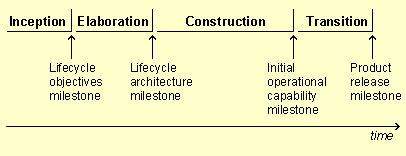Concepts: Evaluating Quality
Throughout the product lifecycle, to manage quality, measurements and assessments of the process and product quality are performed. The evaluation of quality may occur when a major event occurs, such as at the end of a phase, or may occur when an artifact is produced, such as a code walkthrough. Described below are the different evaluations that occur during the lifecycle.
Milestones and Status
Assessments 
Each phase and iteration in the Rational Unified Process results in the release (internal or external) of an executable product or subset of the final product under development, at which time assessments are made for the following purposes:
- Demonstrate achievement of the requirements (and criteria)
- Synchronize expectations
- Synchronize related artifacts into a baseline
- Identify risks
Major milestones occur at the end of each of the four Rational Unified Process phases and verify that the objectives of the phase have been achieved. There are four major Milestones:

- Lifecycle Objectives Milestone
- Lifecycle Architecture Milestone
- Initial Operational Capability Milestone
- Product Release Milestone
Minor milestones occur at the conclusion of each iteration and focus on verifying that the objectives of the iteration have been achieved. Status assessments are periodic efforts to assess ongoing progress throughout an iteration and/or phase.
See also:
- Key Concepts: Work Guideline
- Key Concepts: Artifact Guidelines
- Key Concepts: Checkpoints
- Concepts: Measuring Quality
- Concepts: Process Quality
- Concepts: Product Quality
- Introduction to Project Management
Inspections, Reviews, and
Walkthroughs 
Inspections, Reviews, and Walkthroughs are specific techniques focused on evaluating artifacts and are a powerful method of improving the quality and productivity of the development process. Conducting these should be done in a meeting format, with one worker acting as a facilitator, and a second worker recording notes (change requests, issues, questions, etc.).
The IEEE standard Glossary (1990 Ed.) defines these three kinds of efforts as:
- Review
A formal meeting at which an artifact, or set of artifacts are presented to the user, customer, or other interested party for comments and approval.
- Inspection
A formal evaluation technique in which artifacts are examined in detail by a person or group other than the author to detect errors, violations of development standards, and other problems.
- Walkthrough
A review process in which a developer leads one or more members of the development team through a segment of an artifact that he or she has written while the other members ask questions and make comments about technique, style, possible errors, violation of development standards, and other problems.
See Work Guidelines: Reviews for
additional information on conducting inspections, reviews, and walkthroughs.